Adaptive Polling Medium Access Control Protocol for Optic Wireless Networks
Abstract
:1. Introduction
2. Related Studies
3. Problem Description and Assumptions
4. The Adaptive Polling Medium Access Control (APMAC) Protocol
4.1. Association Phase
- Let represent the theoretical maximum number of VLAN per VLAP.
- Let represent the mean maximum round trip time (RTT) between VLAP and VLN.
- Let collision avoidance slot (CAS), that is the maximum contention time be denoted by
- At the beginning of the slot, the VLAP broadcasts the ADF.
- Upon receiving the ADF, VLNs that wish to associate with the VLAP select a random time . At time z if a VLN senses an idle channel, it sends ARF to VLAP then it waits for AGF. If no AGF arrives within time unit, the VLN checks if .
- If , the VLN selects another random time . At time , VLN sends ARF to the VLAP if the channel is idle, otherwise it checks again if the condition is satisfied then it selects another random time , otherwise it waits another ADF from the VLAP.
- At , the VLAP checks if there is no any ARF that arrived from 0 to then it resets its timer and broadcasts another ADF. This is done to improve system utilization by avoiding idle waiting because VLNs may not receive the ADF from the VLAP, hence no ARF will be transmitted thereby causing idle waiting.
| Algorithm 1: Dynamic future knowledge maximum transmission unit (DFK-MTU) algorithm adopted from [27]. |
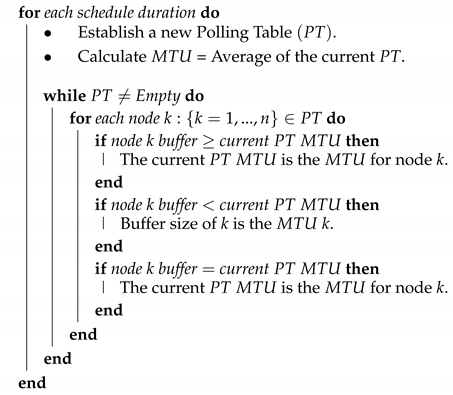 |
4.2. Data Transmission Phase
4.3. Dissociation Phase
5. Experimental Setup and Numerical Results
5.1. Average Delay
5.2. Average Packet Collision versus Network Size and Network Load
5.3. Average System Utilization versus Network Size and Normalized Throughput
5.4. Average System Fairness versus Normalized Throughput and Network Load
6. Conclusions
Author Contributions
Funding
Conflicts of Interest
References
- Cisco VNI Mobile Forecast Highlights, 2016–2021. Available online: https://www.cisco.com/assets/sol/sp/vni/forecast_highlights_mobile/ (accessed on 15 February 2019).
- Smart Insights. Available online: https://www.smartinsights.com/internet-marketing-statistics/happens-online-60-seconds/ (accessed on 15 February 2019).
- Msongaleli, D.L.; Kucuk, K. Reliability and cost-aware network upgrade for the next generation mobile networks. In Proceedings of the 2017 International Conference on Computer Science and Engineering (UBMK), Antalya, Turkey, 5–8 October 2017; pp. 496–501. [Google Scholar]
- Musumeci, F.; Bellanzon, C.; Carapellese, N.; Tornatore, M.; Pattavina, A.; Gosselin, S. Optimal BBU Placement for 5G C-RAN Deployment Over WDM Aggregation Networks. J. Lightw. Technol. 2016, 34, 1963–1970. [Google Scholar] [CrossRef]
- Pure LiFi. Available online: https://purelifi.com/ (accessed on 15 February 2019).
- Tanaka, Y.; Haruyama, S.; Nakagawa, M. Wireless optical transmissions with white colored LED for wireless home links. In Proceedings of the 11th IEEE International Symposium on Personal Indoor and Mobile Radio Communications (PIMRC), London, UK, 18–21 September 2000; pp. 1325–1329. [Google Scholar]
- Visible Light Communications Consortium (VLCC). Available online: http://www.vlcc.net/ (accessed on 15 February 2019).
- Japan Electronics and Information Technology Industries Association (JEITA). Available online: http://www.jeita.or.jp/ (accessed on 15 February 2019).
- Infrared Data Association (IrDA). Available online: http://www.irda.org (accessed on 15 February 2019).
- Home Gigabit Access (OMEGA) Project. Available online: http:// www.ict-omega.eu/ (accessed on 15 February 2019).
- Visible Light Communications Association (VLCA). Available online: http://vlca.net/ (accessed on 15 February 2019).
- IEEE Standard for Local and Metropolitan Area Networks—Part 15.7: Short-Range Wireless Optical Communication Using Visible Light; IEEE: Piscataway, NJ, USA, 2011; pp. 1–309.
- Haas, H.; Yin, L.; Wang, Y.; Chen, C. What is LiFi? J. Lightw. Technol. 2016, 34, 1533–1544. [Google Scholar] [CrossRef]
- Dimitrov, S.; Haas, H. Principles of LED Light Communications: Towards Networked Li-Fi; Cambridge University Press: Cambridge, UK, 2015. [Google Scholar]
- Pathak, P.H.; Feng, X.; Hu, P.; Mohapatra, P. Visible Light Communication, Networking, and Sensing: A Survey, Potential and Challenges. IEEE Commun. Surv. Tutor. 2015, 17, 2047–2077. [Google Scholar] [CrossRef]
- Zhang, Y.; Yu, H.; Zhang, J.; Zhu, Y. Signal-Cooperative Multilayer-Modulated VLC Systems for Automotive Applications. IEEE Photonics J. 2016, 8, 1–9. [Google Scholar] [CrossRef]
- Mohammed, D.; Bourzig, D.K.D.; Abdelkim, M.; Mokhtar, K. Digital data transmission via Visible Light Communication (VLC): Application to vehicle to vehicle communication. In Proceedings of the International Conference on Control Engineering and Information Technology (CEIT), Hammamet, Tunisia, 16–18 December 2016; pp. 1–5. [Google Scholar]
- Yamazato, T.; Kinoshita, M.; Arai, S.; Souke, E.; Yendo, T.; Fujii, T.; Kamakura, K.; Okada, H. Vehicle Motion and Pixel Illumination Modeling for Image Sensor Based Visible Light Communication. IEEE J. Sel. Areas Commun. 2015, 33, 1793–1805. [Google Scholar] [CrossRef]
- Petrariu, A.I.; Lavric, A.; Coca, E. VLC for vehicular communications: A multiple input multiple output (MIMO) approach. In Proceedings of the International Conference on Development and Application Systems (DAS), Suceava, Romania, 24–26 May 2018; pp. 134–137. [Google Scholar]
- Masini, B.M.; Bazzi, A.; Zanella, A. Vehicular Visible Light Networks for Urban Mobile Crowd Sensing. Sensors 2018, 18, 1177. [Google Scholar] [CrossRef] [PubMed]
- Masini, B.M.; Bazzi, A.; Zanella, A. Vehicular visible light networks with full duplex communications. In Proceedings of the IEEE International Conference on Models and Technologies for Intelligent Transportation Systems (MT-ITS), Naples, Italy, 26–28 June 2017; pp. 98–103. [Google Scholar]
- Eroglu, Y.S.; Guvenc, I.; Pala, N.; Yuksel, M. AOA-based localization and tracking in multi-element VLC systems. In Proceedings of the IEEE Annual Wireless and Microwave Technology Conference (WAMICON), Cocoa Beach, FL, USA, 13–15 April 2015. [Google Scholar]
- Zachar, G.; Vakulya, G.; Simon, G. Design of a VLC-based beaconing infrastructure for indoor localization applications. In Proceedings of the 2017 IEEE International Instrumentation and Measurement Technology Conference (I2MTC), Turin, Italy, 22–25 May 2017; pp. 1–6. [Google Scholar]
- Narmanlioglu, O.; Kizilirmak, R.C.; Miramirkhani, F.; Uysal, M. Cooperative Visible Light Communications with Full-Duplex Relaying. IEEE Photonics J. 2017, 9, 1–11. [Google Scholar] [CrossRef]
- Namonta, P.; Cherntanomwong, P. Real time vital sign transmission using IEEE 802.15.7 VLC PHY-I transceiver. In Proceedings of the International Electrical Engineering Congress (iEECON), Pattaya, Thailand, 8–10 March 2017; pp. 1–4. [Google Scholar]
- Vats, A.; Aggarwal, M.; Ahuja, S. Outage analysis of AF relayed hybrid VLC-RF communication system for E-health applications. In Proceedings of the International Conference on Computing, Communication and Automation (ICCCA), Greater Noida, India, 5–6 May 2017; pp. 1401–1405. [Google Scholar]
- Msongaleli, D.L.; Kucuk, K. Dynamic Future Knowledge Maximum Transmission Unit (DFK-MTU) for Optic Wireless Networks. In Proceedings of the 2018 26th Signal Processing and Communications Applications Conference (SIU), Izmir, Turkey, 2–5 May 2018. [Google Scholar]
- Rao, S.P.V.S.; Chalam, S.V.; Rao, D.S. A Survey on MAC Protocols for Wireless Multimedia Networks. Int. J. Comput. Sci. Eng. Surv. 2011, 2, 57–74. [Google Scholar] [CrossRef]
- Kalfas, G.; Pleros, N. An Agile and Medium-Transparent MAC Protocol for 60 GHz Radio-Over-Fiber Local Access Networks. J. Lightw. Technol. 2010, 28, 2315–2326. [Google Scholar] [CrossRef]
- Maniotis, P.; Kalfas, G.; Alonso, L.; Verikoukis, C.; Pleros, N. Throughput and delay fairness through an agile medium-transparent MAC protocol for 60GHz fiber-wireless LAN networks. In Proceedings of the 2012 IEEE Wireless Communications and Networking Conference (WCNC), Shanghai, China, 1–4 April 2012; pp. 3769–3773. [Google Scholar]
- Kalfas, G.; Vardakas, J.; Alonso, L.; Verikoukis, C.; Pleros, N. Non-Saturation Delay Analysis of Medium Transparent MAC Protocol for 60 GHz Fiber-Wireless Towards 5G mmWave Networks. J. Lightw. Technol. 2017, 35, 3945–3955. [Google Scholar] [CrossRef]
- Le, N.; Jang, Y.M. Broadcasting MAC protocol for IEEE 802.15.7 visible light communication. In Proceedings of the 2013 Fifth International Conference on Ubiquitous and Future Networks (ICUFN), Da Nang, Vietnam, 2–5 July 2013; pp. 667–671. [Google Scholar]
- Kramer, G.; Mukherjee, B.; Pesavento, G. IPACT a dynamic protocol for an Ethernet PON (EPON). IEEE Commun. Mag. 2002, 40, 74–80. [Google Scholar] [CrossRef]
- Le, N.T.; Choi, S.; Jang, Y.M. Cooperative MAC protocol for LED-ID systems. In Proceedings of the (ICTC), Seoul, Korea, 28–30 September 2011; pp. 144–150. [Google Scholar]
- Xu, B.; Zhang, M.; Sha, Y. Design of Media Access Control in visible light communication system and a simple way to avoid dual transmit over dual Access Point. In Proceedings of the 2016 15th International Conference on Optical Communications and Networks (ICOCN), Hangzhou, China, 24–27 September 2016; pp. 1–3. [Google Scholar]
- Liu, H.; Zhang, L.; Jiang, M. Energy efficient medium access scheme for visible light communication system based on IEEE 802.15.7 with unsaturated traffic. IET Commun. 2016, 10, 2534–2542. [Google Scholar] [CrossRef]
- Wang, Z.; Liu, Y.; Lin, Y.; Huang, S. Full-duplex MAC protocol based on adaptive contention window for visible light communication. IEEE/OSA J. Opt. Commun. Netw. 2015, 7, 164–171. [Google Scholar] [CrossRef]
- Mao, Q.; Yue, P.; Xu, M.; Ji, Y.; Cui, Z. OCTMAC: A VLC based MAC protocol combining optical CDMA with TDMA for VANETs. In Proceedings of the 2017 International Conference on Computer, Information and Telecommunication Systems (CITS), Dalian, China, 21–23 July 2017; pp. 234–238. [Google Scholar]
- Kim, B.; Kim, S.W.; Fang, Y.; Wong, T.F. Link-adaptable polling-based MAC protocol for wireless LANs. In Proceedings of the IEEE Global Telecommunications Conference GLOBECOM, Dallas, TX, USA, 29 November–3 December 2004; pp. 2997–3001. [Google Scholar]
- Vega, M.T.; Famaey, J.; Koonen, A.M.J.; Liotta, A. Resource allocation in optical beam-steered indoor networks. In Proceedings of the IEEE/IFIP Network Operations and Management Symposium, Istanbul, Turkey, 25–29 April 2016; pp. 418–426. [Google Scholar]
- Nishio, T.; Nishioka, R.; Morikura, M.; Yamamoto, K. VRMAC: A novel WLAN medium access control mechanism using LEDs and a camera. In Proceedings of the IEEE Globecom Workshops, Atlanta, GA, USA, 9–13 December 2013; pp. 1121–1126. [Google Scholar]
- Wang, Q.; Giustiniano, D. Intra-Frame Bidirectional Transmission in Networks of Visible LEDs. IEEE/ACM Trans. Netw. 2016, 24, 3607–3619. [Google Scholar] [CrossRef]
- Liu, H.; Zhang, L. A Medium Access Scheme with Dynamic Contention Window-based Successive Transmission for Visible Light Communications System. In Proceedings of the 2016 International Conference on Information and Communication Technology Convergence (ICTC), Jeju, Korea, 19–21 October 2016; pp. 499–504. [Google Scholar]
- Nobar, S.K.; Mehr, K.A.; Niya, J.M. Comprehensive performance analysis of IEEE 802.15.7 CSMA/CA mechanism for saturated traffic. IEEE/OSA J. Opt. Commun. Netw. 2015, 7, 62–73. [Google Scholar] [CrossRef]
- Mai, V.V.; Thang, T.C.; Pham, A.T. CSMA/CA-based uplink MAC protocol design and analysis for hybrid VLC/Wifi networks. In Proceedings of the IEEE ICC Workshops, Paris, France, 21–25 May 2017; pp. 457–462. [Google Scholar]
- Liu, H.; Zhang, L.; Wu, Z. A successive transmission medium access scheme with dynamic contention window for VLC system with saturated traffic. Photonic Netw. Commun. 2017, 34, 63–74. [Google Scholar] [CrossRef]
- Ayyash, M.; Elgala, H.; Khreishah, A.; Jungnickel, V.; Little, T.; Shao, S.; Rahaim, M.; Schulz, D.; Hilt, J.; Freund, R. Coexistence of WiFi and LiFi Toward 5G: Concepts, Opportunities, and Challenges. IEEE Commun. Mag. 2016, 54, 64–71. [Google Scholar] [CrossRef]
- Hongxu, L.; Shengda, T.; Liansheng, T.; Wei, Z. Blocking and delay analysis of single-wavelength optical buffer with delay constrained packets. Photonic Netw. Commun. 2018, 35, 11–19. [Google Scholar] [CrossRef]
- Zabini, F.; Bazzi, A.; Masini, B.M.; Verdone, R. Optimal Performance Versus Fairness Tradeoff for Resource Allocation in Wireless Systems. IEEE Trans. Wirel. Commun. 2017, 16, 2587–2600. [Google Scholar] [CrossRef]
- Jain, R.; Durresi, A.; Babic, G. Throughput Fairness Index: An Explanation. ATM Forum, February 1999. [Google Scholar]
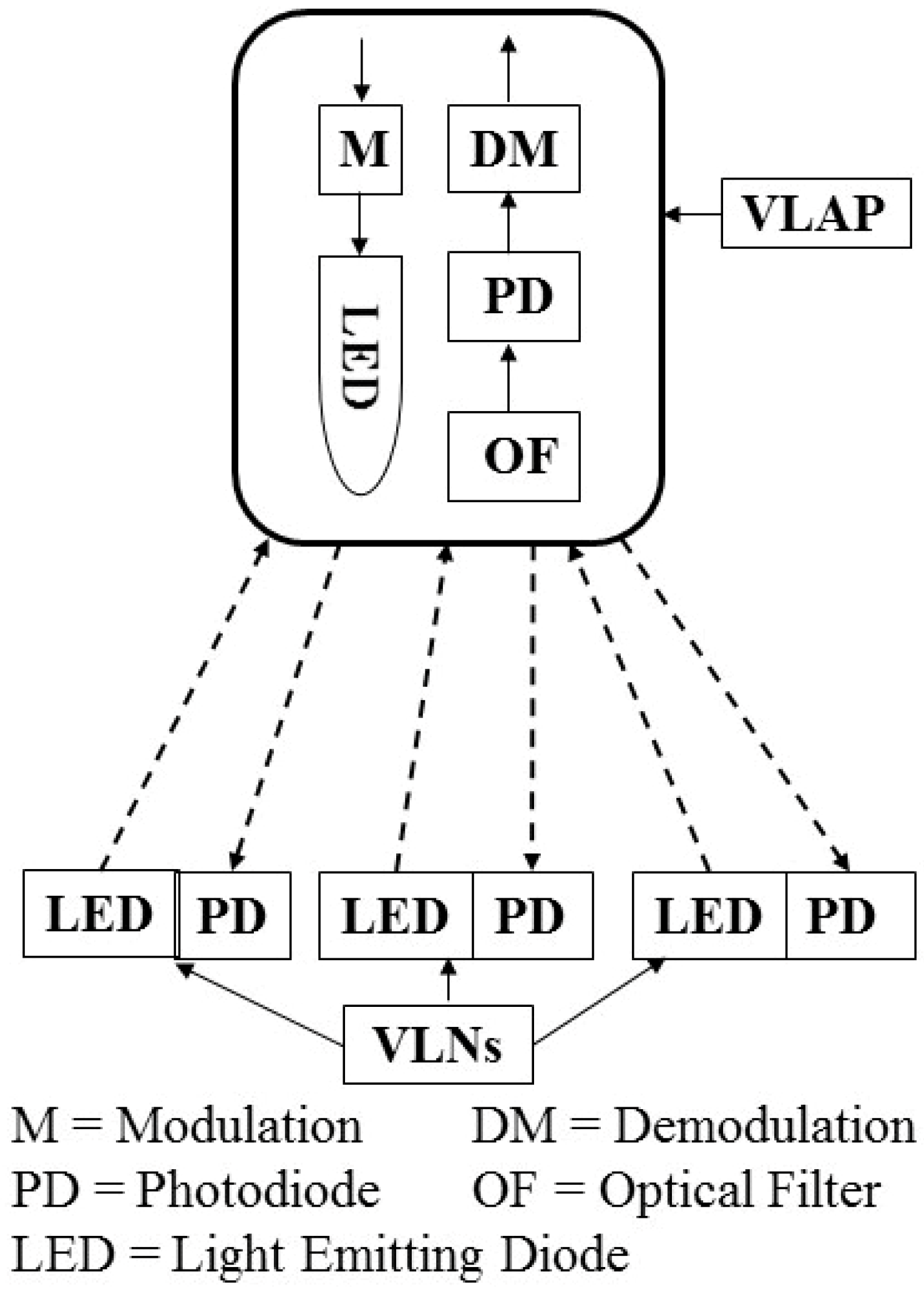
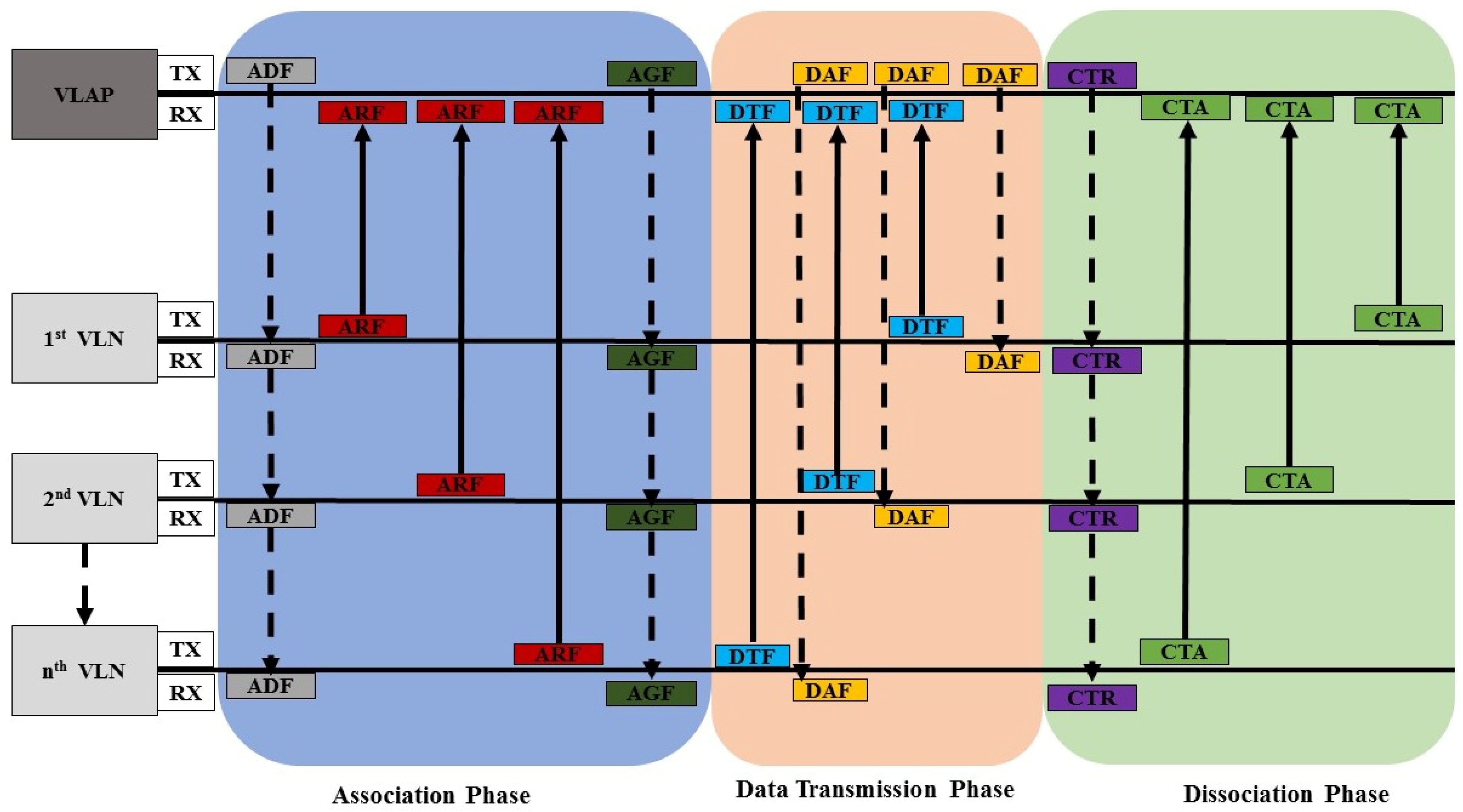
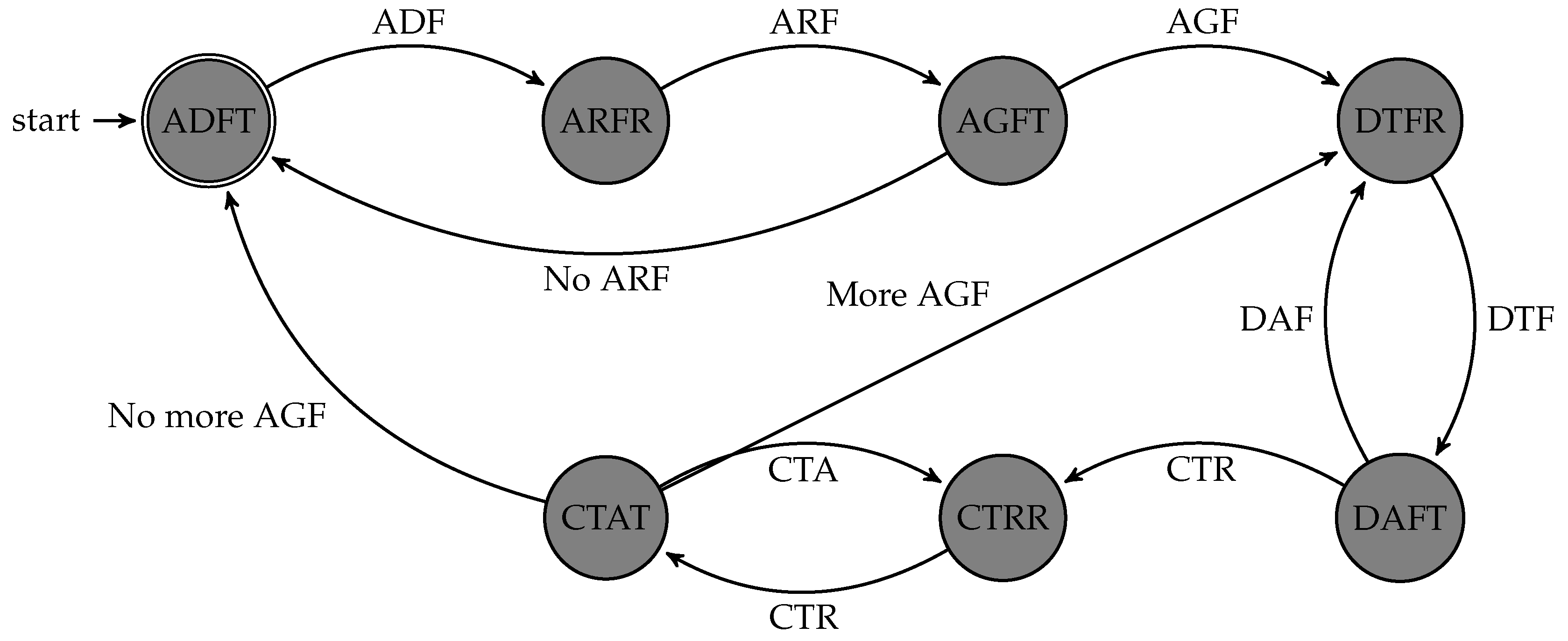
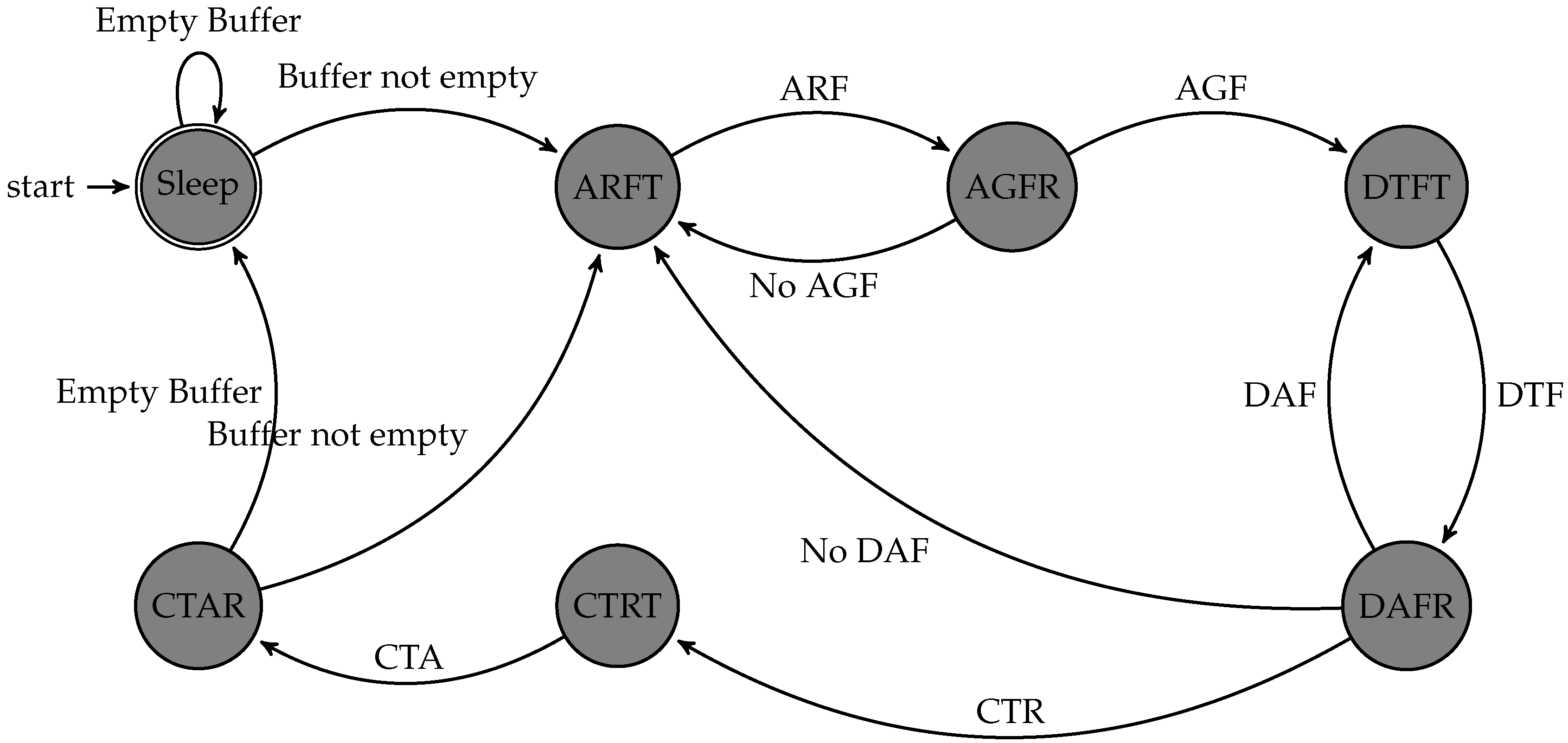
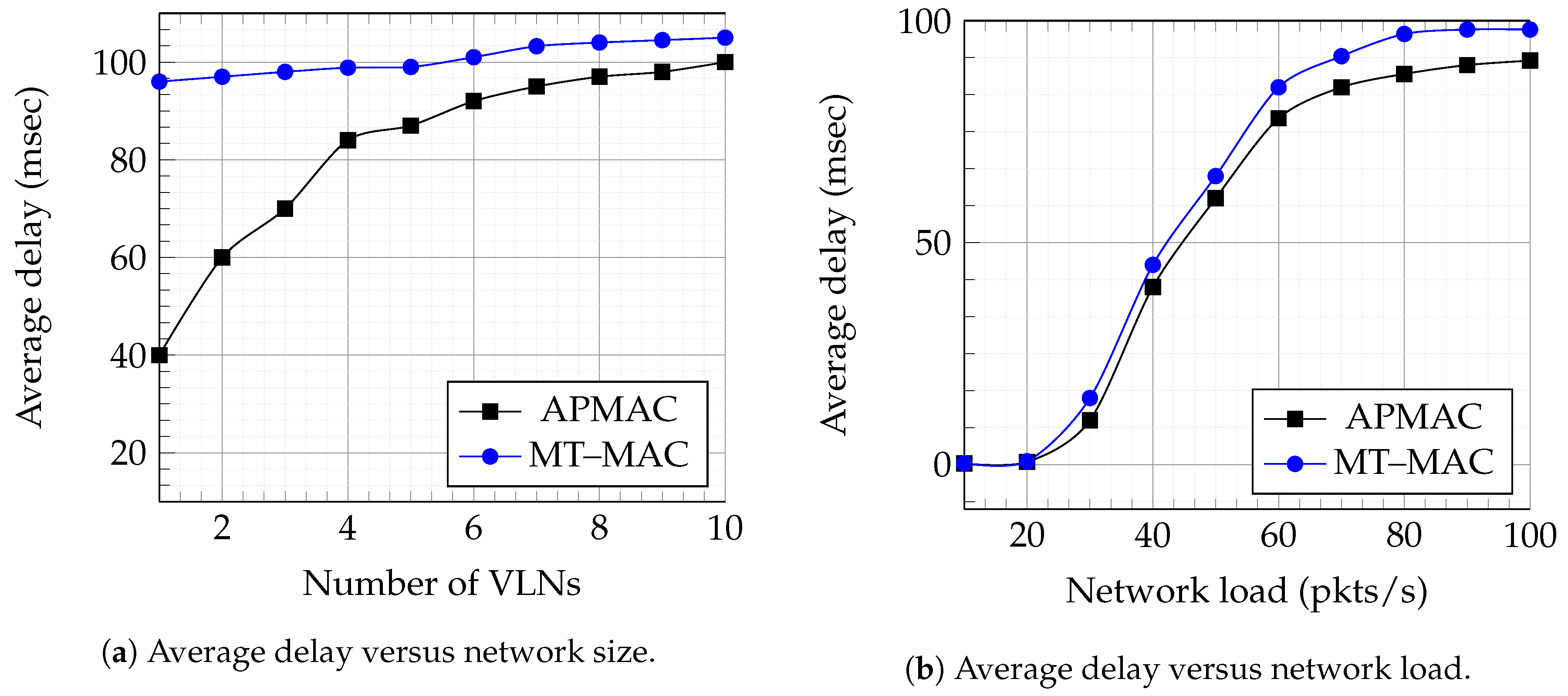
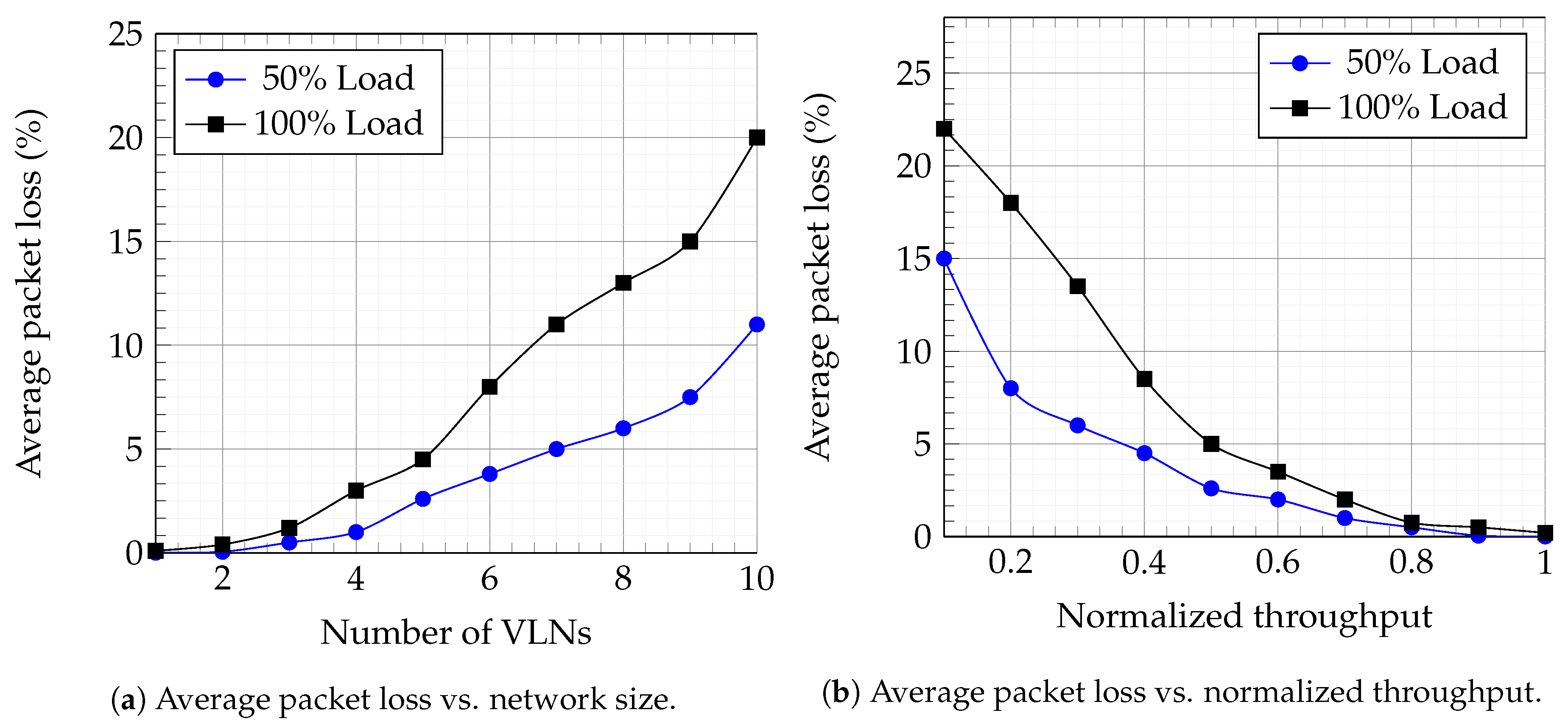
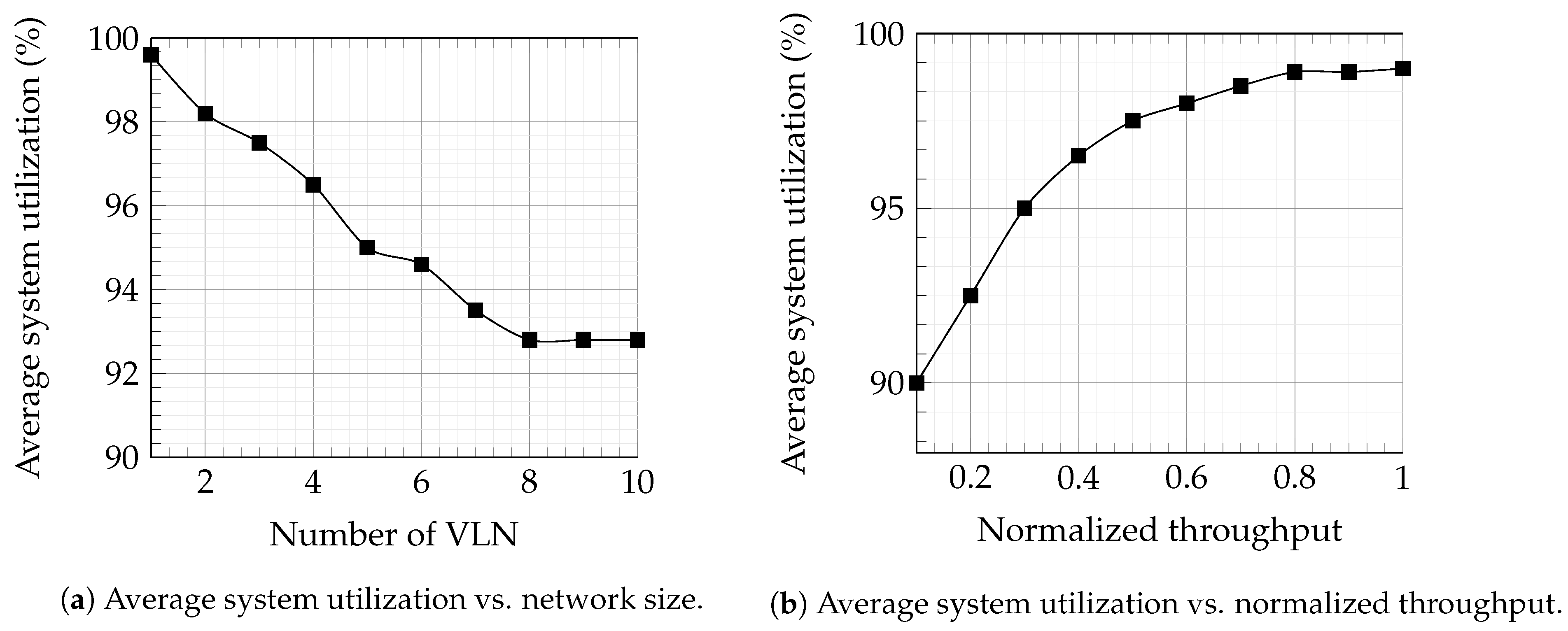
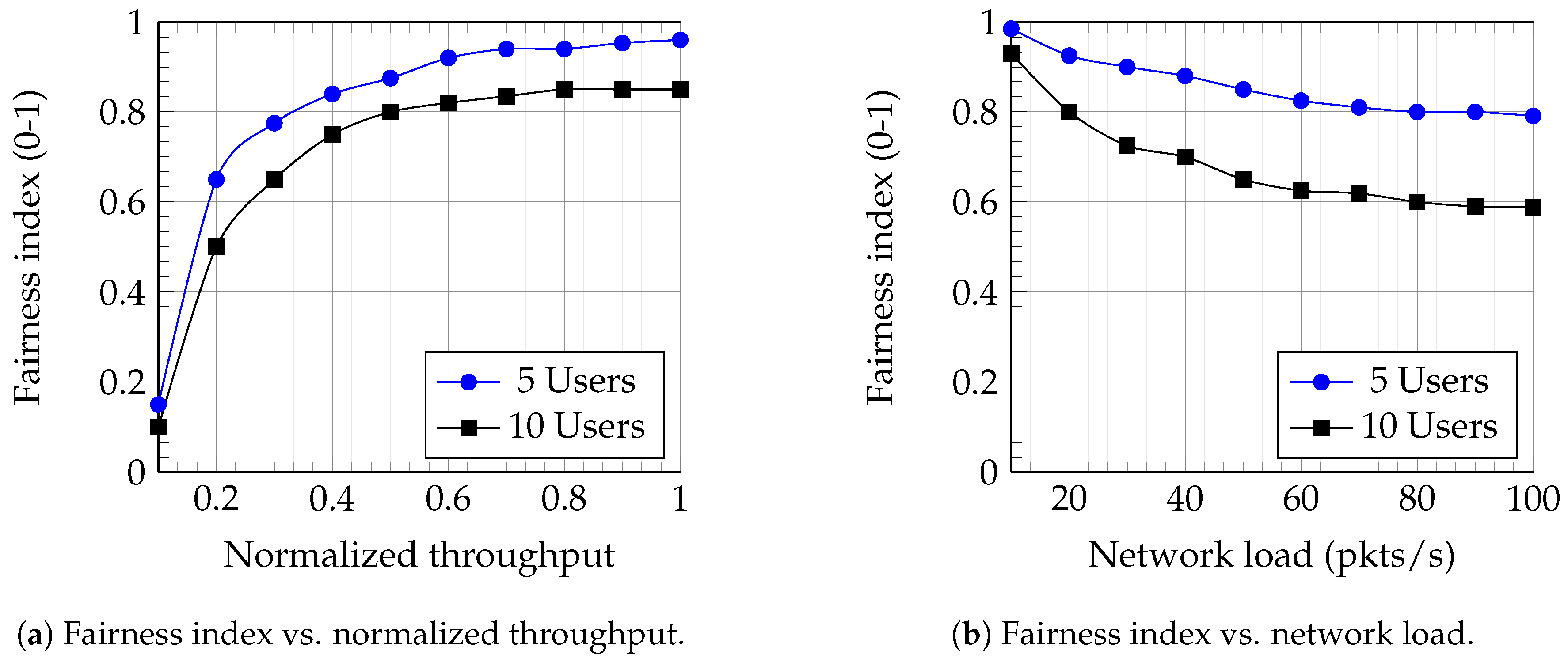
| Study | Type | Transmission Medium | Application | Waiting Time | Utilization | Fairness |
|---|---|---|---|---|---|---|
| Kalfas et al. [29] | Contention | Radio over Fiber (RoF) | Outdoor | Yes | No | No |
| Maniotis et al. [30] | Contention | Radio over Fiber (RoF) | Outdoor | Yes | No | No |
| Kalfas et al. [31] | Contention | Radio over Fiber (RoF) | Outdoor | Yes | No | No |
| Le et al. [32] | Channelization (TDMA) | Visible light spectrum | Indoor | No | No | No |
| Kramer et al. [33] | Non-contention (Adaptive Polling) | EPON | Outdoor | Yes | Yes | No |
| Le et al. [34] | Contention | Visible light spectrum | Outdoor | No | Yes | No |
| Xu et al. [35] | Contention | Visible light spectrum | Indoor | No | No | No |
| Liu et al. [36] | Contention | Visible light spectrum | Indoor | No | No | No |
| Wang et al. [37] | Contention | Visible light spectrum | Indoor | No | Yes | No |
| Mao et al. [38] | Channelization (TDMA and CDMA) | Visible light spectrum | Vehicular Communication | Yes | Yes | No |
| Kim et al. [39] | Non-contention (Multi-Polling) | Radio spectrum | Indoor | Yes | No | No |
| Vega et al. [40] | Channelization (TDM) | Visible light spectrum | Indoor | No | Yes | No |
| Nishio et al. [41] | Contention | Radio and Visible light spectrum | Indoor | No | Yes | No |
| Wang et al. [42] | Contention | Visible light spectrum | Indoor | No | Yes | No |
| Liu et al. [43] | Contention | Visible light spectrum | Indoor | Yes | Yes | Yes |
| Nobar et al. [44] | Contention | Visible light spectrum | Indoor | Yes | Yes | No |
| Mai et al. [45] | Contention | Radio and Visible light spectrum | Indoor | Yes | Yes | No |
| Heting et al. [46] | Contention | Radio and Visible light spectrum | Indoor | Yes | Yes | No |
| This study | Non-contention (Adaptive Polling) | Visible light spectrum | Indoor | Yes | Yes | Yes |
| Abbreviation | Complete Form |
|---|---|
| VLAP | Visible light access point |
| VLN | Visible light node |
| ADF | Availability data frame |
| ARF | Access request frame |
| AGF | Access grant frame |
| DAF | Data availability frame |
| DTF | Data transmission frame |
| FOV | Field of view |
| RTT | Round trip time |
| MTU | Maximum transmission unit |
| CTR | Connection termination request |
| CTA | Connection termination acknowledgment |
| ADFT | Availability data frame transmission state |
| ADFR | Availability data frame reception state |
| ARFT | Access request frame transmission state |
| ARFR | Access request frame reception state |
| AGFT | Access grant frame transmission state |
| AGFR | Access grant frame reception state |
| DAFT | Data availability frame transmission state |
| DAFR | Data availability frame reception state |
| DTFT | Data transmission frame transmission state |
| DTFR | Data transmission frame reception state |
| CTRT | Connection termination request transmission state |
| CTRR | Connection termination request reception state |
| CTAT | Connection termination acknowledgment Transmission state |
| CTAR | Connection Termination acknowledgment Reception state |
© 2019 by the authors. Licensee MDPI, Basel, Switzerland. This article is an open access article distributed under the terms and conditions of the Creative Commons Attribution (CC BY) license (http://creativecommons.org/licenses/by/4.0/).
Share and Cite
Msongaleli, D.L.; Kucuk, K.; Kavak, A. Adaptive Polling Medium Access Control Protocol for Optic Wireless Networks. Appl. Sci. 2019, 9, 1071. https://doi.org/10.3390/app9061071
Msongaleli DL, Kucuk K, Kavak A. Adaptive Polling Medium Access Control Protocol for Optic Wireless Networks. Applied Sciences. 2019; 9(6):1071. https://doi.org/10.3390/app9061071
Chicago/Turabian StyleMsongaleli, Dawson Ladislaus, Kerem Kucuk, and Adnan Kavak. 2019. "Adaptive Polling Medium Access Control Protocol for Optic Wireless Networks" Applied Sciences 9, no. 6: 1071. https://doi.org/10.3390/app9061071
APA StyleMsongaleli, D. L., Kucuk, K., & Kavak, A. (2019). Adaptive Polling Medium Access Control Protocol for Optic Wireless Networks. Applied Sciences, 9(6), 1071. https://doi.org/10.3390/app9061071





